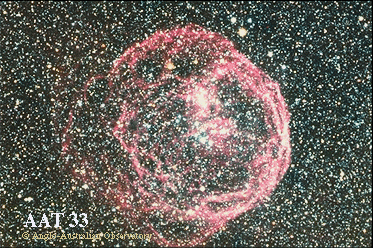Astronomy Picture of the Day
Discover the cosmos!
Each day a different image or photograph of our fascinating universe is
featured, along with a brief explanation written by a professional
astronomer.
May 10, 1996

Henize 70: A SuperBubble In The LMC
Credit:
Anglo-Australian Telescope
photograph by David Malin
Copyright:
Anglo-Australian Telescope
Board
Explanation:
Massive stars (tens of times the mass of the Sun) profoundly affect
their galactic environment. Churning and mixing the
clouds of gas and dust between the stars,
they leave their mark in the compositions
and locations of future generations of stars and star systems.
Dramatic evidence of this is beautifully illustrated
in our neighboring galaxy,
the Large Magellanic Cloud (LMC),
by the lovely ring shaped nebula,
Henize 70 (also known as
N70 and DEM301). It is actually a luminous
"superbubble" of interstellar gas about 300 lightyears in diameter, blown by
winds from hot, massive stars and
supernova explosions,
its interior filled with tenuous
hot expanding gas. These superbubbles
offer astronomers a
chance to explore this crucial connection between the
lifecycles of stars and the evolution of galaxies.
Tomorrow's picture: Sunlight Through Saturn's Rings
| Archive
| Index
| Search
| Glossary
| Education
| About APOD |




Authors & editors:
Robert Nemiroff
(GMU) &
Jerry
Bonnell (USRA).
NASA Technical Rep.:
Sherri
Calvo.
Specific rights apply.
A service of:
LHEA
at
NASA/
GSFC




